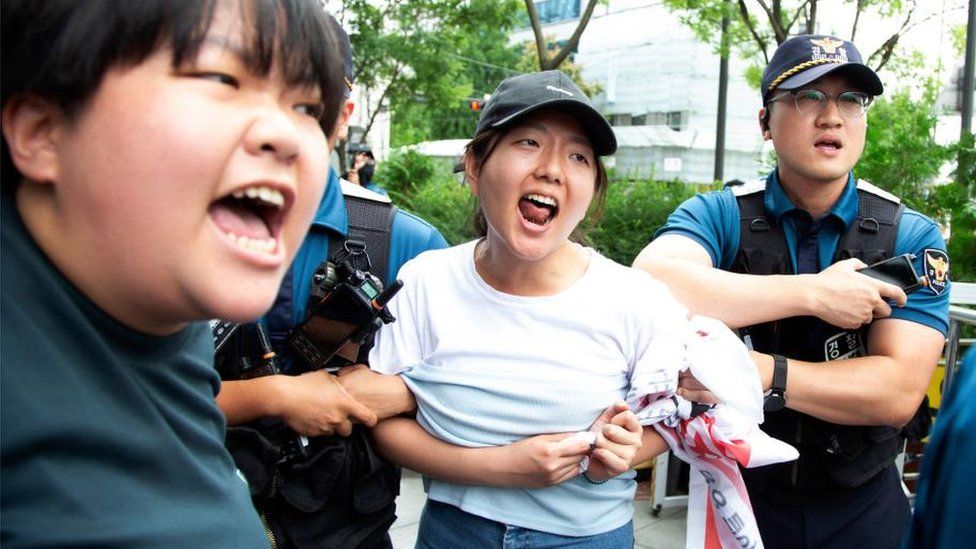14 minutes ago
About sharing
Japan has begun its controversial discharge of treated waste water from the Fukushima nuclear plant into the Pacific Ocean, sparking protests in the region and retaliation from Beijing.
China is the biggest buyer of seafood from Japan, and on Thursday it said it would block all such imports.
Japan say the water is safe, and many scientists agree. The UN’s nuclear watchdog has also approved the plan.
But critics say more studies need to be done and the release should be halted.
More than a million tonnes of water stored at the nuclear plant will be discharged over the next 30 years.
China, which has been the most vocal of opponents since the plan was announced two years ago, called the water discharge an “extremely selfish and irresponsible act” and said Japan was “passing an open wound onto the future generations of humanity”.
Shortly afterwards, China’s customs office announced that an existing ban on seafood imports from Fukushima and some prefectures would be immediately extended to cover the whole of Japan to “protect the health of Chinese consumers”.
The move is calculated to inflict economic damage, and Japan has admitted that businesses will take a “significant” hit. Mainland China and Hong Kong together import more than $1.1bn (£866m) of seafood from Japan every year – making up nearly half of Japan’s seafood exports.
Burt analysts say that the reactions from China in particular, are as much motivated by politics as they are by genuine concerns.
Tokyo’s relationship to Beijing has deteriorated in recent years as it draws closer to the US and also shows support to Taiwan, an island which sees itself as independent but which China claims as its own.
“This incident is more of a symptom than a cause of worsening Sino-Japanese relations,” said Chinese foreign policy expert Neil Thomas with the Asia Society Policy Institute.
“Beijing may have made less of a fuss about the water release if its relationship with Tokyo was in a better place.”
In return, Japan is likely to “reject this criticism, but they are unlikely to do anything provocative,” said James DJ Brown, a professor specialising in Japanese foreign policy expert at Temple University’s Japan campus.
“While Japan’s government is deeply concerned by what it sees as the aggressive actions of the Chinese Communist Party, they understand that it is in their interests to maintain stable relations with their larger neighbour.”
But it may not need to wait for long. Some observers believe that China may not stick with the ban.
“China’s growing economic difficulties could mean that any ban is relatively brief and narrow, so as to limit the negative impact on Chinese importers and business sentiment,” said Mr Thomas.
South Korea also has a longstanding ban on some Japanese seafood. But on Thursday its government had a more muted reaction.
Prime Minister Han Duck-soo said “what is important now is whether Japan, as it promised to the international community, strictly follows the scientific standards and transparently provides information”.
Seoul and Tokyo have drawn closer despite deep historical grievances, united in their allyship to the US while facing down threats from North Korea and China.
However, most South Koreans are opposed to the water’s release, and on Thursday protesters in Seoul attempted to storm the Japanese embassy. Angry demonstrations were also held in Hong Kong and Tokyo.
Meanwhile Mark Brown, chair of the Pacific Islands Forum which had previously castigated the plan, said they now believe the plan “meets international safety standards”.
‘Negligible impact’ on environment
Since a tsunami destroyed the Fukushima nuclear plant in 2011, power plant company Tepco has been pumping in water to cool down the reactors’ fuel rods. This means every day the plant produces contaminated water, which is treated and stored in massive tanks.
Even after treatment, the water contains unacceptably high levels of radioactive substances tritium and carbon-14 which are difficult to remove. Japan’s solution is to dilute it with seawater before releasing it into the ocean.
More than 1,000 tanks have been filled, and Japan says this is not a sustainable long-term solution. It has argued that after treatment and dilution the water is safe to release.
Many scientists have backed the plan, saying it is sound. The UN’s International Atomic Energy Agency has also said the plan complies with international standards and would have a “negligible” impact on the environment.
Authorities have promised to continuously monitor levels of radiation in the ocean and to maintain a high level of transparency.
But there are some who are still sceptical given Tepco’s track record – the company has in the past been blamed for a lack of transparency over the disaster, which it has apologised for.
And while disposing treated water in the ocean is common practice for nuclear plants, critics have pointed out that the amount being released from Fukushima is on an unprecedented, far vaster scale.
Some scientists say more studies should be done on how it would affect the ocean bed and marine life. Environmental activist group Greenpeace has also called for the water to stay in the tanks until better processing technology is invented.
The plan has particularly angered coastal communities and fishermen in Japan. They fear it would harm their livelihoods as some worried consumers avoid seafood from the area, which has never fully recovered economically since the 2011 disaster.
The wider Japanese public also remains deeply divided on the issue, with only half supporting the water’s discharge according to the latest polls.
“I think there should have been many other methods… instead of releasing it into the ocean,” Tokyo protester Keiko Kisei told Reuters on Thursday.
“However, they chose to discharge the water and cause trouble to the world. It’s absolutely unacceptable.”
Fukushima fishermen worried about nuclear water release plan
Related Topics
20 hours ago
13 July
